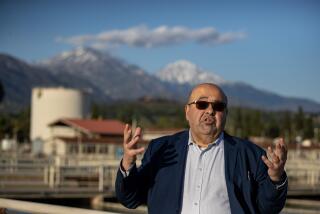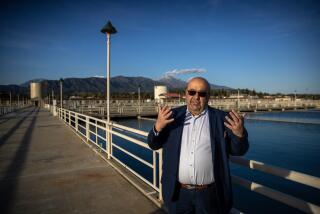Water Firm Awash in Political Influence
- Share via
Let us today hoist a glass -- preferably of cool, clean Colorado River water -- to Keith Brackpool, a walking illustration of how the generous bestowal of campaign donations and other largess can keep a man cozy with California politicians, even in the face of evidence that what he’s selling may not be worth buying.
Brackpool is the chairman and chief executive of Cadiz Inc. For years, Cadiz tried to entice the Metropolitan Water District into a $150-million scheme to store surplus water from the Colorado in the Mojave Desert. The skeptical MWD, which serves most of Southern California, finally nixed the project in 2002.
But Brackpool has never gone away, possibly because he hopes to exploit his political connections to revive the plan. Over the years, he has hobnobbed with Democratic politicians ranging from former Gov. Gray Davis to Los Angeles Mayor Antonio Villaraigosa.
The latest moth caught circling his flame is Susan Kennedy, Gov. Schwarzenegger’s chief of staff. As my colleague Robert Salladay reported last week, Kennedy, a Democrat, received $120,000 from Cadiz as a “consultant” in 2005 while serving on the state Public Utilities Commission. The PUC doesn’t directly regulate Cadiz, but it has a considerable voice in water policy, a topic that also falls within Kennedy’s current portfolio.
It’s timely, therefore, to recall what we know about Brackpool and Cadiz.
First, the desert water scheme. When proposed by Cadiz in 1997, it had a charming 25-words-or-less simplicity: The MWD would store surplus water under Cadiz’s 35,000 acres in wet years and retrieve it during droughts, paying Cadiz a fee at both ends.
But complexities soon surfaced. The storage site lies 35 miles from the MWD’s Colorado aqueduct, so a $100-million pipeline strung over an environmentally sensitive route was required. The proposal also committed the district to buy huge quantities of groundwater from the aquifer underlying the site, but experts disagreed about how much could be safely extracted; the U.S. Geological Survey regarded Cadiz estimates as optimistic by a factor of 10. And a persistent drought on the Colorado, along with interstate squabbles over its water, raised doubts over whether there would ever be surplus for the MWD to store.
Nor were the background and financial condition of Cadiz comforting. The company had no expertise in large-scale water storage and no experience managing big construction projects. The company and water district were to split the $150-million cost down the middle, but most of the Cadiz share was to be fronted by the MWD through a $54-million “prepayment” even before construction began. Far from being available for construction, however, that advance arguably was subject to attachment by Cadiz’s creditors. For its part, Cadiz would collect more than $500 million in fees over 50 years.
Then there was Brackpool himself, a smooth-talking Brit with a curious past. In 1983 he had pleaded guilty to criminal charges in London, including dealing in securities without a license, and paid a $3,200 fine. He hadn’t disclosed this to American regulators, he said, because he regarded the charges as equivalent to misdemeanors. In 1991, he had lost his job as an executive for a highflying British food company after some financial dealings with a direct competitor came to light. He told me in 2002 that the transaction was legitimate but had acquired a bad odor when the competitor ended up at the center of a sensational business scandal.
Brackpool did, however, collect Democratic politicians like a navel collects lint. Tony Coelho, a former California congressman and chairman of the party’s congressional campaign committee, served on the Cadiz board from 1999 to 2003. Former Arizona governor and Interior Secretary Bruce Babbitt joined to work on international deals. (Nothing came of his efforts.) Villaraigosa signed on as a consultant for two years before becoming mayor; Cadiz, Brackpool and others connected with the company contributed a total of $43,650 to his political campaigns from 1999 through 2005. Another consultant was former state Assemblyman Richard Katz, who last week came within a hair’s breadth of being named chief executive of the MWD.
The chief beneficiary of the Cadiz dole was Gray Davis, whose 1998 and 2002 gubernatorial campaigns collected $235,000 in donations. In gratitude, Davis made Brackpool his advisor on water, a relationship that put pressure on the MWD to play ball with Cadiz. Nevertheless, by 2002 the district, fed up with the project’s drawbacks, pulled the plug.
Since then, Cadiz has been scarcely more than a financial shell. A money-losing farming subsidiary, which provided almost all its cash flow and incurred most of its debt, went bankrupt in 2003 and was liquidated.
But some at Cadiz believe there’s life in the water project yet. “An awful lot has changed,” Richard E. Stoddard, a Denver investor who is now chairman and CEO of Cadiz Real Estate, a wholly owned subsidiary that controls the Mojave land, told me last week.
He observes that in 2003 and 2004, “when nobody would have said the project is going forward,” the company still managed to raise $35 million from private investors. He contends this is a sign that big investors aren’t yet bailing out. Much of that money went to pay down the company’s debt to its senior lender, the investment bank ING. The loan now stands at $25.9 million, with a mandatory $10-million principal payment, for which new capital will have to be raised, due in 2008.
Stoddard agrees that there’s probably no way Cadiz could hook up again with the MWD and that it can’t build the project on its own. But he says that other public agencies like regional water districts might be willing to join Cadiz in a new partnership.
And what then? Stoddard acknowledges that environmental studies will need to be updated and political opposition quelled, among other obstacles. But he makes it sound as though, despite nearly a decade of discussion and debate, Cadiz may be with us for at least a few years more.
Golden State appears every Monday and Thursday. You can reach Michael Hiltzik at golden
[email protected] and view his weblog at latimes.com
/goldenstateblog.
More to Read
Get the L.A. Times Politics newsletter
Deeply reported insights into legislation, politics and policy from Sacramento, Washington and beyond. In your inbox three times per week.
You may occasionally receive promotional content from the Los Angeles Times.











